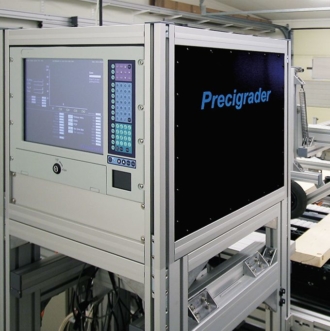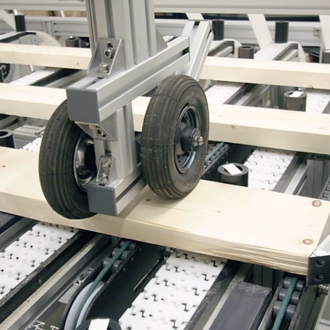Strength grading equipment
The first strength grading machines for structural timber came to Finland in the mid-1970.
In the next decade, the machines became common in both BS, Nordic T and INSTA sorting roles. There were Computermatic, Raute Timgrader and Cook Bolinder strength grading machines. For the sorting of the highest grades of the German DIN4074, only the machines of Dimter or Grecon were approved. The other highest permissible class was C24 according to DIN norm.
Taivuttavista koneista akustiseen menetelmään
In the 1990’s, a new type of strength grading machinery was introduced to BS and T grading: the Swedish Dynalyse’s Dynagrade machine with a capacity of 100 pcs/min and U.S. Metriguard with a capacity of 400 m/min.
The Dynagrade strength grading machine was a so-called “knocking machine”, which was based on acoustic measurement when the sound echo of the hammer travelled end to end of the board.
Dynagrade strenght grading equipment.
© Limab Oy
Wood density data
In the development stage of the Dynagrade, it was already identified that adding the wood density data to the measurement parameters would improve sorting accuracy and yield.
In 2006, Dynalyse AB launched a new version of Dynagrade, named Precigrader. It used the oscillation technique and the density data together as the basis for grading. It reached a higher degree of accuracy by simultaneously preserving the high capacity and the compact design.
Nowadays, most machines use the oscillation as a primary feature.


Approved for machine strength grading of timber
According to the harmonized product standard EN14081-4:2009, the following strength grading equipment (characteristics in brackets) are approved for machine strength grading of timber:
- Cook Bolinder (bending stiffness)
- Computermatic and Micromatic (bending stiffness)
- Diamond Timgrader (bending stiffness)
- Euro-GreComat 702 (X-rays)
- Euro-GreComat 704 (X-rays and bending stiffness)
- Euro-GreComat 706 (oscillation and Xrays)
- GoldenEye 702 (X-rays)
- GoldenEye 706 (oscillation and X-rays)
- ViSCAN (oscillation)
- Dynagrade (oscillation)
- Precigrader (oscillation and gravimetric density)
- Timber Grader MTG (oscillation)
- Grademaster (X-rays and wicrowave radiation)
- E-Scan (oscillation)
- Triomatic (speed of ultrasonic wave)
The grading systems of BoardScanner by RemaSawco, BoardMaster by Finscan Oy and of ProfiGrade by Lisker Oy can be used for strength grading alone or combined with other equipment. Both systems are based on the visual measurement and they are suitable for visual control of machine strength grading.


